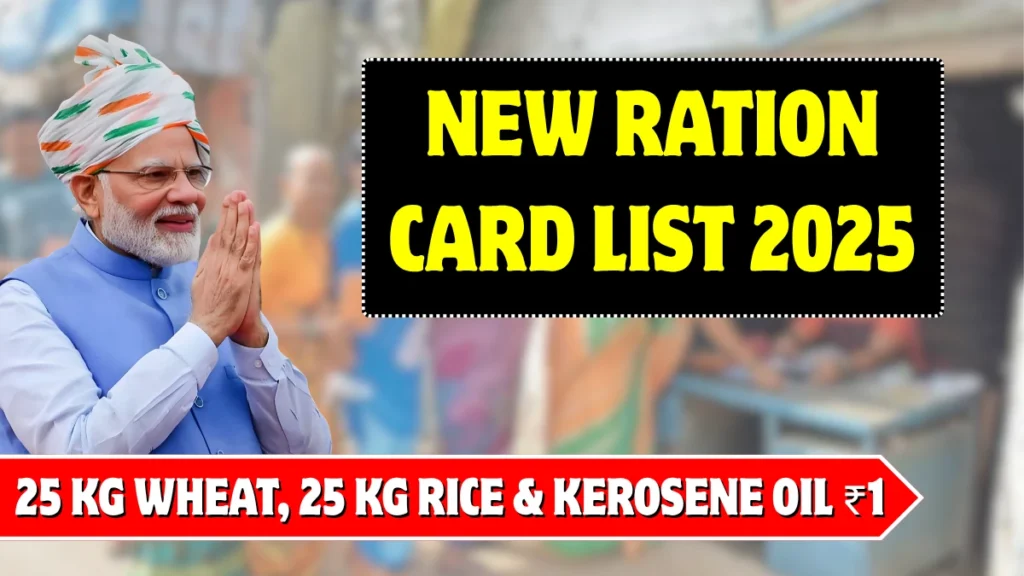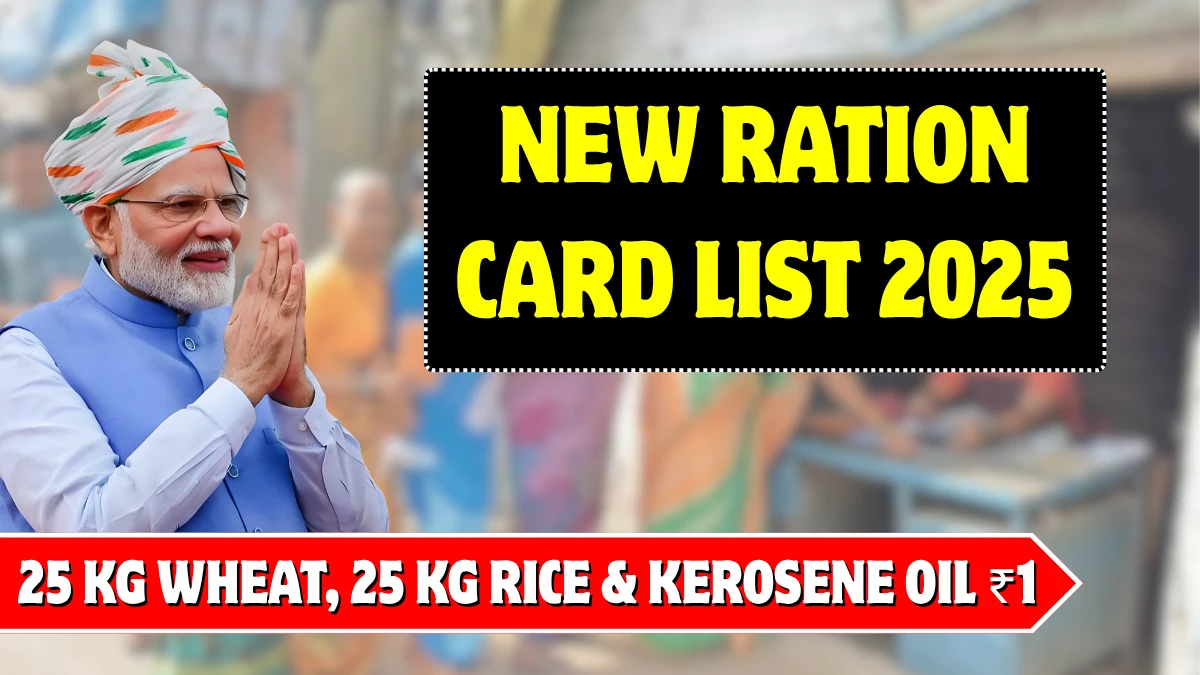The government has once again focused on making essential food items affordable for every household in the country. Under the National Food Security Act (NFSA), a new ration card list for 2025 has been released, allowing eligible families to access a variety of food grains and kerosene oil at extremely low prices.
This initiative aims to support the economically weaker sections and ensure that no one is deprived of basic necessities. With this new announcement, millions of families will benefit from heavily subsidized food and fuel. The highlight of the scheme is the provision of 25 kilograms of wheat, 25 kilograms of rice, and kerosene oil at just one rupee.

Government Scheme Main Focus
The primary goal of the scheme is to strengthen food security in rural and urban areas. Many families depend on the public distribution system to meet their daily needs, and this updated ration card list ensures that more households can be included. By keeping the price at one rupee, the government intends to reduce the financial burden on the poor and promote equal access to essential items. This step also aligns with the larger objective of building a hunger-free society, where no citizen sleeps on an empty stomach.
Ration Card List Details
The new ration card list for 2025 contains the names of beneficiaries who will receive subsidized rations under the NFSA scheme. This list has been prepared after thorough verification to ensure that only eligible families are included. Those whose names appear on the list can visit their nearest ration shops to collect the allotted items. The digital availability of the list also makes the process more transparent, enabling anyone to check their status from home. The inclusion of both rural and urban households ensures a wide reach of the benefits.
Items Distributed At Subsidy
Under this scheme, every eligible ration card holder will receive 25 kilograms of wheat, 25 kilograms of rice, and kerosene oil for just one rupee. These commodities are considered essential for everyday living in most Indian households. Wheat and rice provide a basic source of nutrition, while kerosene oil remains crucial in many rural areas where access to electricity or cooking gas is still limited. By offering these items at a nominal price, the government is effectively ensuring that even the most vulnerable families can afford daily essentials.
Eligibility For Scheme Access
To access the benefits of the scheme, families must hold a valid ration card under the NFSA framework. Priority households, Antyodaya Anna Yojana beneficiaries, and those identified as economically weaker are eligible to receive the subsidized items. The verification process ensures that the benefits reach genuine recipients and are not misused. In many states, ration cards are also linked with Aadhaar to avoid duplication and fraud. This step simplifies the entire process and makes distribution smoother for both beneficiaries and authorities.
Application And Verification Steps
Those who are not yet included in the new ration card list but meet the eligibility criteria can apply through their state food department. Applications can be submitted online or through local ration offices. After submission, the authorities will verify documents, income details, and household information to ensure eligibility. Once approved, the name will be added to the beneficiary list, and the family can start receiving subsidized items from the next distribution cycle. The transparent verification system minimizes the risk of errors and delays.
Benefits For Poor Families
This scheme brings immense relief to low-income families, especially those struggling with rising food prices. By receiving a significant portion of their food requirements at almost no cost, families can save money for other essential needs like education, healthcare, and transportation. It also helps in improving nutritional levels among children and vulnerable groups. For families living in remote rural areas, access to kerosene oil at a minimal price is particularly beneficial. It provides them with a reliable source of fuel for lighting and cooking.
Distribution Process Made Simple
The distribution process has been designed to be smooth and hassle-free. Beneficiaries need to visit their nearest fair price shop with their ration card and identification documents. Digital systems are now being used in most states to record transactions and reduce manual errors. This not only improves efficiency but also prevents ration diversion. Regular monitoring by government officials ensures that every family receives the exact quantity of grains and kerosene oil allotted to them. Transparency at every stage is a key focus of the new plan.
Digital List Checking Option
Checking the new ration card list has become easier than ever with the introduction of digital access. Beneficiaries can visit their respective state’s food department portal to check their names using their ration card number or Aadhaar number. This feature saves time and eliminates the need to visit government offices repeatedly. In case of any discrepancy, users can also raise a request for correction or inclusion. By making this process online, the government has taken a major step toward modernizing the public distribution system.
Impact On Rural Economy
The new ration card scheme is not only about providing affordable food but also about boosting the rural economy. When basic needs are met at a low cost, families can use their savings to invest in small businesses, education, or healthcare. This creates a positive cycle of growth and development in villages and small towns. Moreover, regular supply of grains and kerosene supports local ration dealers and ensures the smooth functioning of fair price shops. A stable and accessible distribution system benefits both citizens and the economy.
Importance Of Food Security
Food security has always been a top priority for national development. A country can only progress when its citizens are well-nourished and healthy. By introducing affordable ration schemes, the government ensures that the basic right to food is protected for every individual. The NFSA scheme has played a crucial role in reducing hunger and malnutrition over the years. The latest update strengthens this commitment and provides a strong foundation for a more secure and inclusive future.
Future Of Ration Schemes
The government is gradually moving toward complete digitalization of ration distribution. Biometric systems, Aadhaar linkage, and online lists are making the process more transparent and efficient. In the coming years, ration delivery may also include doorstep options for those unable to visit distribution centers. By constantly improving the system, the government aims to eliminate corruption and ensure that every eligible family receives their rightful share. This new ration card list is an important step in that direction.
Conclusion Of New Scheme
The release of the new ration card list for 2025 is a major relief for millions of families across the country. By offering 25 kilograms of wheat, 25 kilograms of rice, and kerosene oil at one rupee, the government has reaffirmed its commitment to ensuring food security for all. With transparent digital systems, simplified distribution, and strict verification, the scheme promises to reach those who need it most. It is not just a welfare program but a strong step toward a more secure, equitable, and hunger-free nation.
Disclaimer
The information provided in this blog post is based on government announcements and publicly available data as of 2025. While every effort has been made to ensure accuracy, the details of the ration card list and the NFSA scheme may vary by state and are subject to change. Readers are advised to verify their eligibility and other specifics with their local food distribution offices or official government websites. This blog does not guarantee inclusion in the ration card list or the availability of subsidized items.
